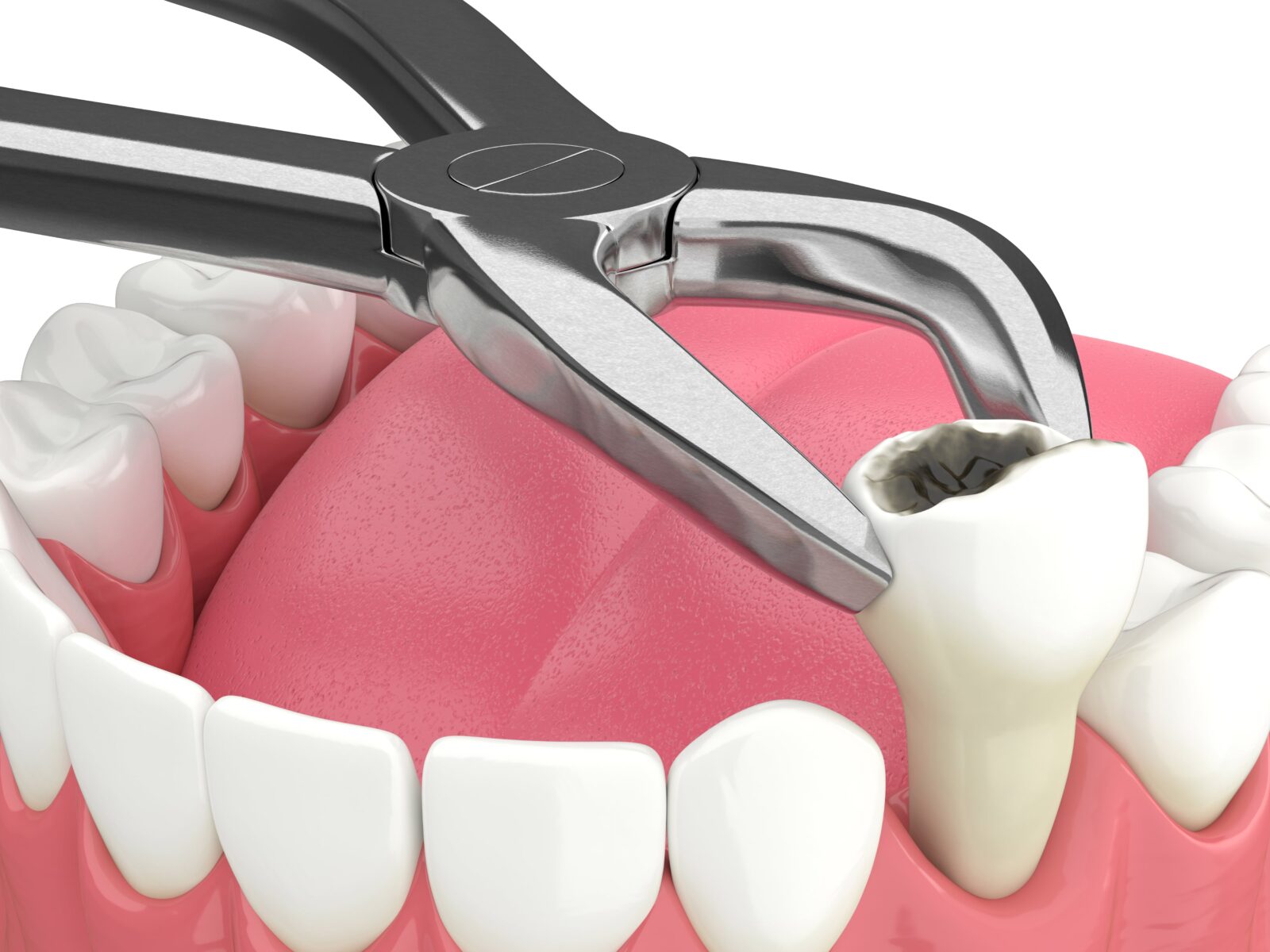Facing a tooth extraction can be daunting, but being well-informed about the process can significantly alleviate your concerns. Each year, millions of people undergo tooth extractions for a variety of reasons, whether it’s due to an impacted tooth, infection, or preparation for braces. In this blog, we will demystify the steps involved in tooth extraction, what you should expect during the procedure, and how to care for yourself afterward. Our goal is to equip you with the knowledge you need to ensure a smooth and stress-free experience.
In This Blog:
- Why Tooth Extractions Are Necessary
- Getting Ready for a Tooth Extraction
- The Procedure for Removing a Tooth
- Caring for Yourself After a Tooth Extraction
- Common Risks and How to Manage Them
- FAQs
Why Tooth Extractions Are Necessary
Tooth extractions are a common part of dental care, often essential for maintaining oral health. Here are some reasons why dentists might recommend removing a tooth:

Impacted Wisdom Teeth:
These are third molars that fail to emerge properly and can lead to pain, inflammation, and damage to adjacent teeth.
Advanced Decay:
When a tooth is severely decayed, and restoration is not viable, extraction is necessary to halt the spread of decay and infection.
Orthodontic Corrections:
Removal of certain teeth may be necessary to make space for improved alignment during orthodontic work, particularly in cases of overcrowded teeth.
Gum Disease:
Severe periodontal disease can weaken the support structures of teeth, leading to their removal to preserve overall oral health.
Infection Risk Reduction:
For individuals undergoing treatments like chemotherapy or organ transplants, even a minor infection from a compromised tooth can pose severe health risks, necessitating preemptive removal.
Dental Abscess:
A severe infection characterized by swelling, pain, and pus may require the removal of the affected tooth if other treatments fail to resolve the issue.
Dental Trauma:
Significant trauma to the mouth can result in teeth being so damaged that they require extraction to pave the way for further restorative measures.
Each reason underscores the importance of extractions as a preventative or corrective measure, aimed at sustaining or enhancing overall dental health.
Getting Ready for Tooth Extraction
Proper preparation for a tooth extraction can help ensure the procedure goes smoothly and can aid in a quicker recovery. Here are essential steps to prepare:
Review of Medical History:
It’s vital to share your complete health history with your dentist, including any medications and supplements you’re taking, to avoid complications during the extraction.
X-rays:
Taking X-rays allows the dentist to plan the best approach for removing the tooth by revealing its position and the condition of the surrounding bone.
Discussing Anesthesia:
Talk with your dentist about your anesthesia options to ensure a pain-free procedure. Options range from local anesthesia to more extensive forms like sedation or general anesthesia, depending on the extraction’s complexity.
Fasting:
If using sedation or general anesthesia, you may need to fast for a specified period before the procedure. Your dentist will give you exact instructions based on the anesthesia type.
Medication Adjustments:
Certain medications may need to be paused or adjusted before the extraction to prevent excessive bleeding. This should always be done under professional guidance.
Arranging Transportation:
Arrange for someone to drive you home post-procedure, especially if you’re receiving sedation or general anesthesia, as you will not be in a condition to drive.
Home Preparation:
Prepare your home for your return by setting up a comfortable area where you can rest and recover. Have soft foods and ice packs ready to help with the initial recovery phase.
Appropriate Attire:
Wear comfortable, loose-fitting clothing to your appointment. Avoid wearing anything constrictive or complicated, as you’ll want to be as relaxed as possible during the procedure.
By carefully preparing for your tooth extraction, you can minimize discomfort and ensure a rapid and straightforward recovery process. Always adhere closely to the guidelines provided by your dentist to avoid complications.
The Procedure for Removing a Tooth
The process of removing a tooth is meticulously designed to minimize discomfort and ensure safety. Here’s a detailed explanation of what happens during a tooth extraction:
Administering Anesthesia:
To start, anesthesia is applied to numb the area and make the procedure pain-free. Depending on the case, this might be:
- Local Anesthesia: This numbs just the extraction site. You stay awake but won’t feel pain.
- Sedation Anesthesia: Given through an IV, this type of anesthesia reduces your awareness of the procedure and you might not remember it afterward.
- General Anesthesia: In complex cases, this may be used to put you completely to sleep.

Extraction Techniques:
The dentist will then proceed to remove the tooth, using specific tools:
- Elevators: These are used to loosen the tooth from its socket by gently rocking it.
- Forceps: Once loose, the tooth is removed with these instruments.
Extraction Type:
There are two types of tooth extractions that your dentist may use. These include:
- Simple Extraction: This is performed on teeth that are visible and easily accessible in the mouth.
- Surgical Extraction: This is necessary for teeth that are not easily accessible, such as those that are broken at the gum line or have not erupted fully. This method may require cutting into the gum.
Closing the Site:
In cases of surgical extractions, the dentist may need to stitch the gums. These stitches may dissolve over time or require removal later.
Post-Extraction Care:
Directly after the extraction, you’ll bite on a sterile gauze to facilitate clotting and control bleeding.
Home Care Instructions:
You will receive detailed guidance on how to care for the extraction site, manage discomfort, and facilitate healing once you leave the dentist’s office.
Understanding the step-by-step procedure can help reduce any anxiety about the extraction and prepare you for what to expect, allowing for a more comfortable experience.
Caring for Yourself After a Tooth Extraction
After a tooth has been removed, following specific care instructions is crucial for healing and avoiding complications. Here are key points to keep in mind for post-extraction care:
Control Bleeding:
Maintain pressure on the extraction site with sterile gauze to help form a blood clot. Replace the gauze as directed by your dentist until bleeding subsides.
Alleviate Pain:
You may experience some discomfort as the anesthesia wears off. Manage this with painkillers as prescribed or recommended by your dentist.
Minimize Swelling:
Apply ice packs to the cheek area over the extraction site to reduce swelling. Do this intermittently for the first 24 hours.
Rest and Limit Activities:
Take it easy for at least 24 hours after the extraction. Avoid any strenuous activities that could dislodge the blood clot from the socket.
Dietary Adjustments:
Stick to soft, cool foods like yogurt, ice cream, and smoothies immediately following the procedure. Gradually reintroduce harder foods as healing progresses.
Avoid Certain Habits:
Refrain from smoking, using straws, or any vigorous rinsing and spitting for at least 24 hours to protect the clot.
Maintain Oral Hygiene:
Continue brushing and flossing your teeth, but be gentle around the extraction site to avoid disrupting the clot. After 24 hours, gently rinse your mouth with warm salt water several times a day to cleanse the area and aid healing.
Watch for Complications:
Keep an eye out for signs of infection such as persistent pain, swelling, or fever. Contact your dentist if you suspect any complications.
Follow-Up Visits:
If stitches were used or if there were complications, a follow-up appointment might be needed to ensure proper healing and to remove any stitches if they aren’t self-dissolving.
By closely following these post-operative care steps, you can help ensure a smooth recovery and minimize discomfort after your tooth extraction.
Common Risks and How to Manage Them
Although tooth extractions are generally safe, they can sometimes lead to complications. Being informed about these potential issues helps in recognizing and addressing them quickly:

Dry Socket:
A particularly common issue after extraction is dry socket, where the blood clot at the site fails to form or is dislodged, exposing bone and nerves. This can lead to significant pain and delayed healing. Avoiding smoking and following post-care instructions closely can reduce this risk.
Infection:
The open wound from an extraction can become infected, marked by increased pain, swelling, and sometimes pus or fever. Maintaining good oral hygiene and following your dentist’s instructions for care are critical to preventing infection.
Persistent Bleeding:
Some bleeding after extraction is normal, but it should diminish within a few hours. Continual bleeding can be managed by applying pressure with sterile gauze and following your dentist’s guidance.
Nerve Damage:
While rare, nerve damage can occur during an extraction, potentially causing numbness or tingling. This is more likely with the extraction of lower wisdom teeth and usually resolves over time, but it can be permanent in rare cases.
Damage to Nearby Teeth:
Tools used during the extraction could potentially harm adjacent teeth or dental restorations. Careful technique and experienced hands are important to minimize this risk.
Sinus Problems:
Extractions in the upper jaw can occasionally lead to complications with the sinuses, such as a communication between the sinus and mouth. Specialized treatments may be necessary if this occurs.
Jaw Issues:
In very rare instances, the force used during an extraction could fracture the jawbone, particularly in patients with osteoporosis or other bone-weakening conditions.
Extended Discomfort:
While some pain after extraction is expected, it should gradually improve. Persistent or worsening pain may need further intervention from your dentist.
Promptly contacting your dentist if you experience any of these symptoms is vital for proper management and quick resolution of complications.
Frequently Asked Questions About Tooth Extractions
Understanding tooth extraction procedures can ease your mind and prepare you for what to expect. Here are answers to some frequently asked questions:
“How long until I recover from a tooth extraction?”

Recovery time can vary but generally, for a simple extraction, most activities can be resumed within a few days. The site itself may take a couple of weeks to heal fully. Surgical extractions may require more downtime.
“Will the extraction hurt?”
You shouldn’t feel pain during the extraction due to anesthesia. Afterward, some discomfort is normal, which can usually be managed with over-the-counter pain relief as directed by your dentist.
“How will I know if I need a tooth extracted?”
Extractions are typically advised for severe decay, infection, impact on other teeth, or preparation for orthodontics. Regular dental exams are crucial as your dentist can identify the need early on.
These FAQs can provide a basic understanding, but for more specific concerns, consult directly with your dentist to get the most accurate and personalized information.
Conclusion
In conclusion, while the thought of a tooth extraction might seem daunting, being well-informed about the procedure, its necessity, the careful steps involved, and the comprehensive aftercare can greatly ease your apprehension and prepare you for a smooth experience. Remember, most complications are preventable with proper care and attention. Following your dentist’s guidelines meticulously will not only expedite your recovery but also optimize your overall dental health. If you have any concerns or symptoms post-extraction, it’s important to communicate with your dentist to ensure a swift resolution. Ultimately, a tooth extraction can significantly contribute to alleviating discomfort, resolving dental issues, and improving your oral health.







